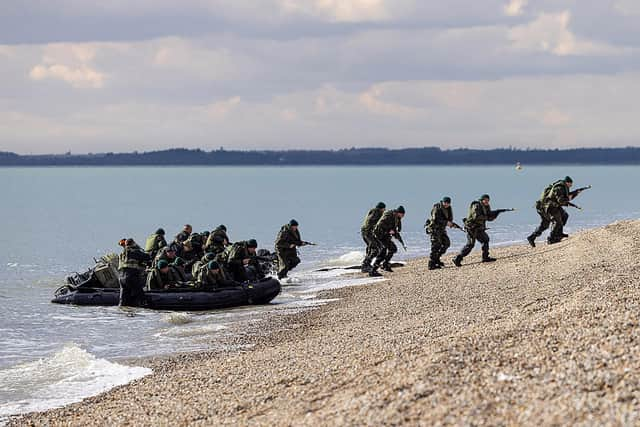The sinister strategic moves behind the ongoing Ukraine-Russia war - Patrick Mercer
First, more peculiar than sinister was last weekend’s ‘peace summit’ held in Jeddah. With rumours suggesting that both sides were inching towards a settlement, the Saudis played host to China, Turkey and Ukraine - but not Russia. Then there was no movement from Kiev who reheated their ten point peace plan which was nothing more than a demand that Russia should unconditionally withdraw from all the land she occupies.
Usually, business is transacted behind the scenes at such events, but without a main antagonist present that could never happen. Although Turkey and China have positioned themselves as future peace brokers, the rest of the summit was simply a charade.
Advertisement
Hide AdAdvertisement
Hide AdIn stark contrast, though, are ideas emerging from the secret conversations between Russian and US intelligence. The fact that such things happen is remarkable enough - but they do - and it’s fascinating to hear that as early as last February CIA Director William Burns offered Russia a “land for peace” deal which was then restated by the chief of staff to NATO’s Secretary General.


A few days ago Stian Jenssen suggested that Donetsk, Luhansk, Kherson and Zaporizhzhia oblasts might be recognised as Russian territory whilst Ukraine would be accepted into NATO - essentially the same plan as that of William Burns.
Now, both Kiev and Moscow shouted the idea down because such a plan flies directly in the face of both countries’ overt war aims. But, it’s this very tactic of suggesting something outrageous that hints at something momentous.
Let’s look at the battlefields for further clarity. Even the most ardent supporters of Ukraine are now admitting that their summer counter offensive has ‘stalled’ on the mines and gunfire of Russian defences whilst the West has yet to provide the fighter aircraft to beat back overwhelming Russian attack helicopters.
Advertisement
Hide AdAdvertisement
Hide AdCertainly, Kiev is having success with drone assaults on Russian cities like Moscow and St Petersburg and raiding into the Belgorod region. Similarly, Russian resupply routes including the vital Chongar and Kertch bridges in the Crimea are being damaged along with warships and merchant craft.
In eastern Donbass President Zelensky’s troops are making some progress as they try to retake Bakhmut but, for the life of me, I cannot see why they’re doing this other than to salve national pride after the city fell earlier this year.
But pride and a series of high profile pinpricks won’t beat Russia: it’s the severing of the land bridge to the Crimea which matters, but other than the seizing of a couple of villages, the hoped for breakthrough is looking more distant than ever.
And what success Kiev is having comes at a cost. It’s fair to assume that Russia - whose troops are deeply entrenched - are taking far fewer casualties than their enemies and, whilst Kiev’s fallen are a closely kept secret, we do know that there are only a handful of troops in training and their parliament has just passed an act to allow all 16 year olds to be conscripted. Unless a NATO nation intervenes, Ukraine is simply going to run out of troops.
Advertisement
Hide AdAdvertisement
Hide AdMeanwhile, almost unmentioned by the Western media, but deeply important, is Moscow’s own counter offensive in the Kharkov region. Kupiansk and other Ukrainian cities are now being evacuated as, some suggest, over 100,000 Russian troops move slowly but deliberately to recapture the ground reclaimed by Ukraine almost a year ago.
It’s this advance, though, that seems so sinister. Now, 100,000 troops are significant, especially in a region which is not heavily defended by Ukraine. They ought to be romping towards the south protected by the Oskil river on their left and outflanking all of Kiev’s forces in eastern Donbas, shouldn’t they? Certainly, they’re meeting opposition, but they’re making remarkably slow progress for such a strong and well equipped force.
But there’s a Russian theory behind all this which - and here’s a health warning - is diametrically opposed to the creed espoused by most of the West: namely, Ukraine’s about to win.
First, Russia believes that direct confrontation with NATO is highly likely and that large numbers of troops need to be kept uncommitted to the fighting but poised to move anywhere they’re needed. Hence the large forces in the north.
Advertisement
Hide AdAdvertisement
Hide AdSecond - the really sinister bit - a deal has already been done between Washington and Moscow where, in return for Russia keeping the pot bubbling but not boiling for another year or so without any major offensives, Joe Biden, at an appropriate point in his election campaign, will be able to announce a peace deal where the shooting stops, Russia gets to keep her newly dominated territories and Kiev is bought off with some sort of NATO membership deal.
The logic continues: if a Republican victory looks likely then Mr Trump or whoever the new President is, will be able to pull peace from the bag as almost his or her first act in office. This all sounds a bit like the scheme first put forward by the CIA Director and now being pushed by the sidekick of NATO’s Secretary General, doesn’t it? And perhaps it’s all just a Kremlin inspired conspiracy theory… perhaps.
Patrick Mercer is a former MP for Newark and Army colonel.